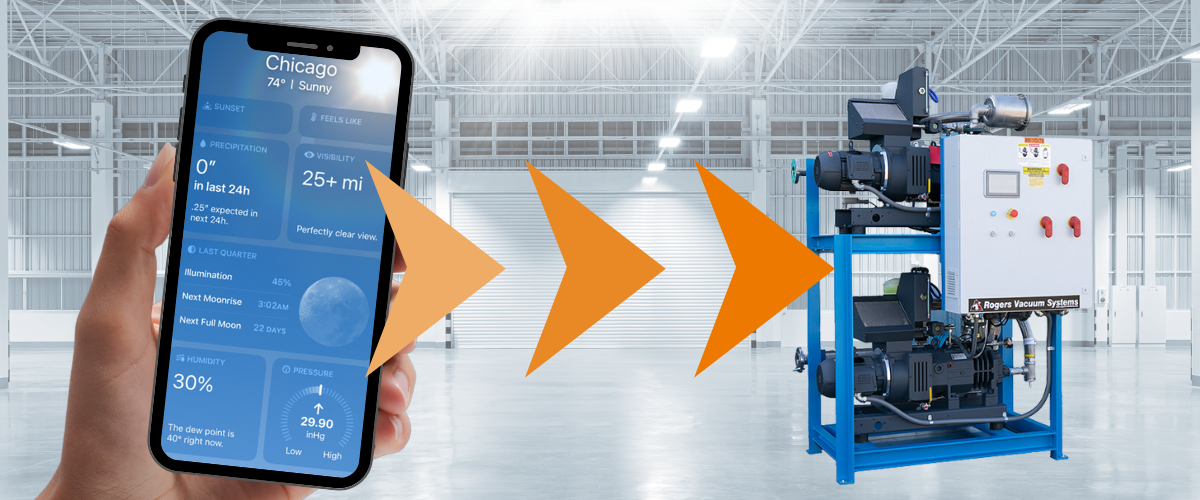Your Cart is Empty

Implementing Vacuum System Innovations in the Real World: How Installation Location & Weather Affect Performance and System Design
High and low atmospheric pressures affect vacuum systems. But how much? In this article, vacuum expert Bryan A. Jensen covers how weather systems on our planet affect vacuum systems and how each type of vacuum usage — utility vacuum or process vacuum — responds to barometric changes in our atmosphere.
Table of Contents
- The "Standard" Pressure Scale Nearly Never Applies
- Understand Your Application and Model for the Extreme
- Utility Applications
- Process Applications
"Sign it." He clapped at me while casually tossing the pen in his fingers onto the table around which a small crowd had gathered. "Oh, and date it too. If we're going to apply for a patent, we'll need that on there." My eyes widened.
Just down the hall, through the double doors and a short bike ride across the factory floor, past the ruddy orange pressure vessel you used to watch lift human beings into orbit on T.V., sat the repurposed hydraulic milling machine on which I'd very recently broken a solid-state welding bit. The mangled hunk of steel was now acting as part inspiration and part paperweight to the large format blueprint we'd just finished sketching on.
Bill's voice was gruff, and his direct nature left many in his tutelage fearful of somehow sparking off the small giant. But with good reason to be angry with me in that moment, he had instead helped turn my failure into our innovation and I saw through his rough exterior. For all his acerbic guidance, he was just trying to change the world, one low-temperature aluminum weld at a time.
I returned to my tiny cubicle with youthful pride and grabbed the corded mouse to wake up the tube monitor which had been tumbling 'NASA' around. My cube-mate Ned and I had recently been having an evening cocktail, one of my first ever, in town down off Tchoupitoulas St. at a locals' cigar bar where he'd told me about a new search engine, claiming it would take over the internet. As my monitor woke, the funny-looking word 'Google' appeared onscreen and a small pop-up window alert flashed up over the top, prioritizing itself from the federal intranet system.
In it, a simple double-bladed icon spun counterclockwise while some government derived weather data scrolled methodically. A hurricane had formed in the Gulf.

Pictured: A hurricane spins in the Gulf of Mexico, viewed from the International Space Station far above Earth's surface.
Key Takeaways
- Real-world performance matters: Field implementation proves the effectiveness of vacuum system innovations beyond theory or lab testing.
- Customization is key: Tailored solutions address specific industry and facility challenges for optimal results.
- Efficiency leads to savings: Modern vacuum systems improve energy efficiency, reducing both costs and environmental impact.
- Teamwork drives success: Collaboration between engineers and on-site operators ensures smooth integration and functionality.
- Maintenance sustains benefits: Continuous monitoring and routine upkeep are essential for long-term performance and reliability.
The "Standard" Pressure Scale Nearly Never Applies
Open up your Vacuum101 training pamphlet, attend a vacuum webinar or thumb through your favorite equipment vendor's literature and you'll undoubtedly find a chart that looks something like the one below. This gives you the not-so-secret decoder ring to convert pressure values into depth of vacuum measurements and vice versa.

The first problem with this (ahem) 'standard' chart is that it is normalized to only one specific elevation; sea level. And, news flash, most industrial air compressors and vacuum pumping systems are not installed on the beach.
As we climb the dune up and away from the ocean, the air which we, our air compressors and car engines ingest gets increasingly rarified, immediately throwing off this simplistic chart on which most of us have based our entire understanding of pressure conversions.

This second chart is a bit truer, but truthfully the complications don't end here. For just as a king crab or cephalopod crawls along the floor at the bottom of their ebullient and crashing fluid ocean; we humans also wander our planet's hills, mountains, and valleys, all of which are, very similarly, at the bottom of a much larger, much deeper ocean. But generally we, like the sea urchins, don't really see it that way.
We all just live, existing in the environment to which we've been adapted. And the vast ocean at the bottom of which homo sapiens, tarantulas, and moose crawl around is not made up of liquid salt water but is instead comprised of unfathomably enormous quantities of gaseous nitrogen and oxygen. Hurricane, nor'easter, sunshine and squall; it should be clearly apparent that the ocean above our heads is just as dynamic and whipping — if not more so — than the salt-watery home of our planet's sea stars.

This last chart attempts to capture the chaos of the changing barometer as the winds crash against our definitions and scales of pressure. But as a static image, even it only approximates a single representative snapshot in time of the ever-changing 'fixed' reference line we call "Zero PSIG" or "Zero Inches of Mercury." On any given Sunday at any given elevation, a storm front could have moved in overnight and the barometer may have dropped by a couple of inches of mercury, or in extreme cases, even more.
Understand Your Application and Model for the Extreme...But Which One?
When grasping to understand a new concept or make the next innovative leap, it is often helpful to imagine the conditions and parameters surrounding whatever is the fresh idea at their extremes, as such an exercise can help to highlight for one's imagination the limitations of possibility. For example, if we want to contemplate the effect of whatever is the day's weather on our industrial vacuum systems, we might want to imagine what would happen to their performance if you tried to operate in a hurricane.
Utility Applications
Depending on your vacuum application, your target depth of vacuum and your existing vacuum pumping technology, an overnight swing of 2" Hg on the barometer may not be that big a deal. For example, say you're using an oil-lubricated rotary vane pump for your meat packing operation, targeting around say 23"-24" HgV while operating at an elevation of several hundred feet above sea level. Chances are that you wouldn't even notice a difference in performance between a sunny day and a typhoon.
But now let's say your neighbor is using the same series of lubricated vane pump that you'd recommended she buy from your cousin-in-law. In her shop, the hold-down application absolutely requires at least 28"HgV. Well, then there is a decent chance she may think you have led her astray for an earned family buck since occasionally the sheet she's routing out flies right off the table and the part is ruined. Even still, it's weird because this only seems to happen when it's raining outside.
In these kinds of utility applications, we commonly and appropriately use terms of differential pressure measurement ("HgV). It is correct to use this scale, taken relative to the undulating barometer, since these applications require the difference between the high air pressure of the world around us and the much lower pressure inside your vacuum system to impart force such that some form of physical work is completed.
In utility use, when the barometer increases above normal, no problem. Things now get even easier for the vacuum pump, since with the increased available pressure the world has to offer, the pump can operate with a higher inlet pressure and still make the target vacuum setting with breeze.
The weather-based trouble here can come when we've sized our system, installed our vacuum tools, selected our pumping technology and are still just barely getting by on a normal weather day. When the wind blows and the barometer drops, the pressure available that the world imparts decreases, and suddenly the vacuum utility fails to perform.

Process Applications
There are also process vacuum applications, those which are meant to control the gaseous and/or liquid contents of some sort of chamber, reactor, still or continuous product-making tube. These applications are best defined when using terms of absolute pressure measurement as the actual pressure inside the vessel, regardless of the elevation or weather outside, will directly correlate to the quantity of ingredients and their conditions in process. It is generally inappropriate to use terms of differential pressure measurement ("HgV) for process applications.
Because process vacuum applications target a sub-atmospheric fixed pressure, often beginning to approach perfect vacuum, and the inlet side of your vacuum pump is directly responsible for maintaining that low-pressure condition, the converse weather challenge occurs.

If we were to put a process application high on the mountaintop or in a low-pressure weather event, the world will have offered our process installation an assist in the form of lower pressure that the exhaust of the vacuum must push against. But as the sun comes out and the barometer goes up, these vacuum pumps and multi-stage hybrid systems must now operate against a higher exhaust pressure while maintaining the same low-low inlet condition.
This barometric increase drives up the mechanical compression ratio ηc. Since all positive displacement compression devices have a limit to their allowable ηc, and as that same ratio increases, pumping performance goes down; therefore, we must plan for this inevitability for process vacuum duty.

We live on a dynamic rock and weather events most certainly matter; just ask those who went through Katrina a few years after my first professional mentor taught me that, sometimes, folly drives breakthrough. When the eye of that particular storm traversed over the top of what, years before, had been mine and Ned's shared cubby, the barometer dropped over two and a half inches of mercury in an eight-hour window.
I was very fortunate to have missed nature's leveling while so many others were not. And while no one would expect to continue operating a manufacturing facility through the destruction and sheer devastation that occurred in that fateful and floodful storm, the measurements of such a weather event help to define the extreme of what is possible for a given locale.
Oh, and by the way those patents issued to Bill and our team have pretty much all expired now, having become public domain a few years back. So go ahead...Google them.
Articles and Case Studies You May Be Interested In: |
View Past Webinar Recordings About Vacuum Topics Such As:
|
Meet the Author
 |
Bryan A. Jensen is a mechanical & aeronautical engineer with over 20 years of application experience in a wide variety of industrial manufacturing processes, focusing on the compressed air & gas industry. Beginning his career as a NASA materials research engineer, he currently heads the Engineered System Solutions team at Rogers. |





